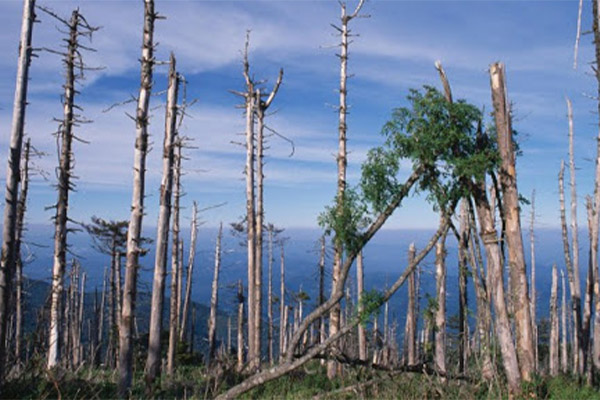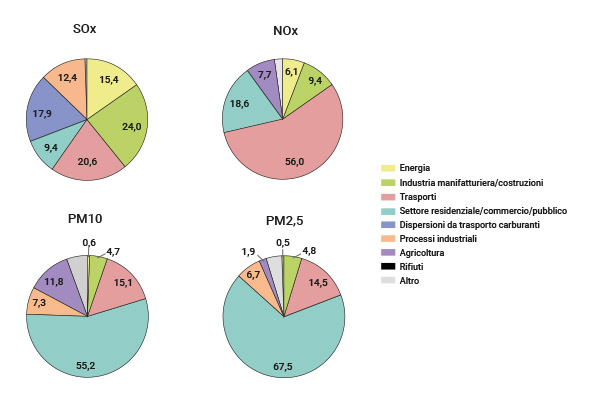What are the most dangerous pollutants from industries ?
In this article, we will explore some of the most dangerous pollutants in the atmosphere, and to what extent the industrial sector contributes to their emission. Contrary to what is commonly thought, considerable progress has been made in the last thirty years in reducing emissions in this sector, while for example in the same period there have been increases in other sectors, such as residential heating.
So, let’s see what are the most polluting substances in the atmosphere.
Sulfur oxides: SOx
When we refer to SOx, we mean the sulfur oxides most present in the atmosphere, which are sulfur dioxide (SO₂) and sulfur trioxide (SO₃). SO₂ is one of the most aggressive and dangerous atmospheric pollutants, the primary source of which is the combustion of coal, oil and diesel. The oxidation of SO₂ generates SO₃, which reacts with water to produce sulfuric acid, the main cause of acid rain.
As detailed in the Italian Institute for Environmental Protection and Research (ISPRA) report ISPRA 2020 - Italian Emission Inventory 1990-2018, Italy has already achieved its SOx reduction targets set for 2030. The greatest contribution to this reduction came precisely from the industrial sector, with decreases nonetheless seen in all sectors, from energy production to the chemical industry. Here, we are talking about a decrease of over 90%. What are the main factors causing this? Well, the main factors include a switch to natural gas from coal and other fossil fuels, a decrease in the percentage of sulfur present in fuels, and stricter laws regulating emissions.

Nitrogen monoxide and nitrogen dioxide: NOx
Now we come to NOx, a term we essentially use to refer to nitrogen monoxide and dioxide (NO and NO₂). These oxides have both natural origins, such as volcanic eruptions, and anthropogenic ones, such as combustion at high temperatures in vehicle engines, or industrial plants that use combustion processes. NO and NO₂ are both toxic to the environment and to health, but the most dangerous is certainly NO₂. In fact, it is one of the bases for the production of secondary pollutants, such as ozone and nitric acid. It also contributes by about a third to the formation of acid rain.
The two sectors that contribute most to NOx emissions are transport and industry. However, we have seen an interesting trend in emissions from 1990 until today.
The ISPRA report speaks of a marked decline, as much -68% from 1990 to 2018, with the two main sectors driving the reduction being precisely transport and industry. In detail, we have seen a reduction of 91% in the energy sector, and 77% in industrial processes.
Similarly to the case of SOx, giving the greatest impetus to cutting emissions was the introduction, from 1988 onwards, of more and more stringent regulations to regulate plant emissions. This was accompanied by replacing the use of fossil fuels with natural gas, the adoption of renewable energy sources, and greater energy savings.
Particulate Matter: PM10 and PM2.5
PM10 and PM2.5 are acronyms that stand for Particulate Matter with a diameter of less than or equal to 10 micrometres (µm) and 2.5 micrometres, respectively. This is therefore very small particulate matter, which is dispersed in the lower atmosphere. The composition of this pollutant come from both natural sources, such as volcanic eruptions, pollen, fires, and so on, and from artificial sources, such as the burning of fossil fuels, with the latter obviously causing the greatest concern.
The dependence of our economy on this type of energy source is still overwhelming. However, in recent years, considerable progress has been made, and the data presented in the ISPRA report for Italy underline this effort. Specifically, the industrial sector that we are evaluating in this article has seen a decline in emissions of both types of particulate matter. Let’s see the details.
In the period from 1990 to 2018, PM10 emissions decreased by approximately 40%. If we look at the data by sector, the sharpest decline occurred precisely in the industrial sector, by -71% in industrial combustion, -49% in manufacturing, and -98% in the energy sector. Regarding PM2.5, the percentage drop was -67% in combustion processes, and -97% in manufacturing and energy.

Source: Ispra Report - Informative Inventory Report 2020 - Italian Emission Inventory 1990-2018
These results have been achieved thanks to stricter regulations on industrial emissions. Which, consequently, has led residential heating to be the main source of particulate matter, as no control measures have been put in place in this sector.
Air pollution in Italy
What can we deduce from the data trend? The positive news is undoubtedly the general drop in emissions for the industrial sector, even though overall there is still a lot of work to be done, especially regarding the residential and commercial heating sector.
In industry, the decline in emissions was due to several concomitant factors: the replacement of fuels such as coal with, for example, methane gas, more stringent regulations and controls on emissions, but also a delocalization of manufacturing, and the economic crisis of 2008 .
In addition, in the specific case of Italy, part of the reduction was due to a decrease in the productivity of cement factories and several chemical companies .
Overall, we can therefore say that we are moving in the right direction. However, we need to be aware that, on the road to sustainability and cutting emissions, we need to work much harder to achieve carbon neutrality, which is the goal now being set globally.